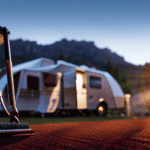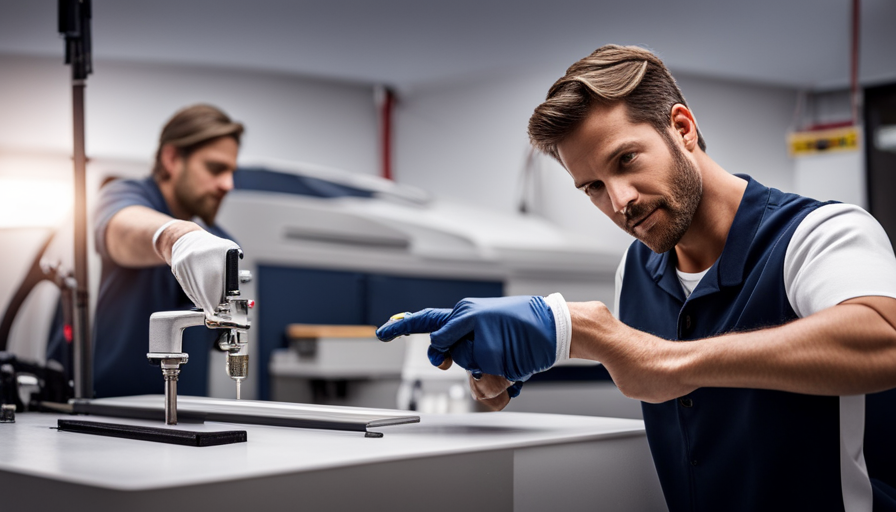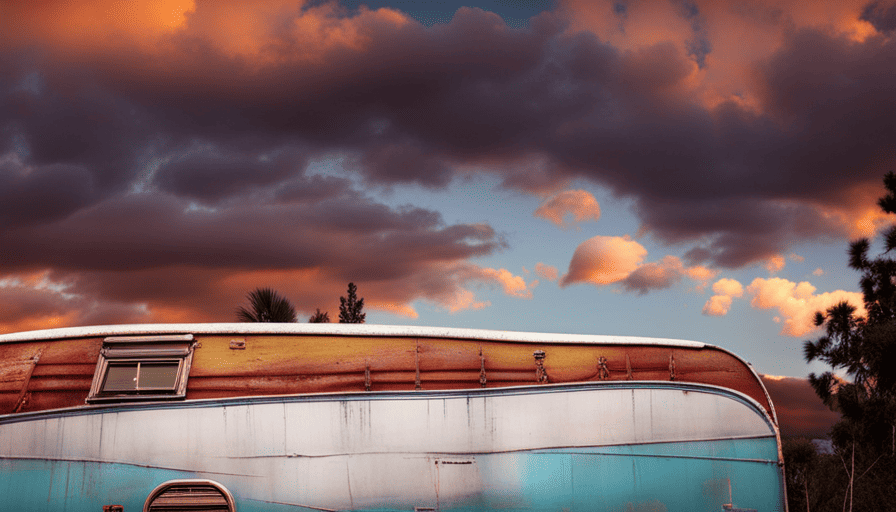Are you prepared to set out and embark on your upcoming camping journey? Before you go, it’s crucial to make sure your camper awning is spotless and in pristine condition. A dirty awning is not only unattractive but it can also become a breeding ground for mold and mildew.
In this article, I will guide you through the process of cleaning the underside of your camper awning, step by step. By following these simple instructions, you can maintain a clean and inviting outdoor living space while on the road.
From gathering the necessary supplies to inspecting for any remaining stains, I will provide you with all the information you need to make your awning shine.
So, let’s get started and make sure your camper awning is ready for your next adventure!
Key Takeaways
- Gather necessary cleaning supplies: ladder, soft-bristle brush or sponge, bucket of warm water, mild detergent.
- Choose the right cleaning solution for the specific awning material (fabric, vinyl, acrylic).
- Regularly clean the underside of the awning to maintain a clean outdoor space.
- Ensure the awning is completely dry before retracting it and use mildew-resistant fabric.
Gather the necessary cleaning supplies
You’ll need to gather the necessary cleaning supplies in order to effectively clean the underside of your camper awning. Cleaning the underside of your awning is an important part of proper maintenance, as it helps to remove dirt, debris, and any potential mold or mildew that may have accumulated.
Here are some cleaning tips and the supplies you’ll need to get the job done right.
First, you’ll need a ladder to safely reach the underside of the awning. Make sure the ladder is stable and secure before climbing up.
Next, gather a soft-bristle brush or sponge, a bucket filled with warm water, and a mild detergent specifically designed for awnings. Avoid using harsh chemicals or abrasive cleaners, as they can damage the fabric.
To begin the cleaning process, dip the brush or sponge into the soapy water and gently scrub the underside of the awning. Pay special attention to any areas that appear dirty or stained. Rinse the brush or sponge frequently to remove dirt and debris.
Once you have thoroughly cleaned the underside of the awning, rinse it off with clean water using a hose or a bucket. Make sure to remove all soap residue to prevent any potential damage to the fabric.
Allow the awning to air dry completely before retracting it.
To extend the awning fully and secure it in place, refer to the manufacturer’s instructions. This step is important to ensure the awning is properly supported and doesn’t collapse during the cleaning process.
Extend the awning fully and secure it in place
Once the awning’s fully extended and securely fastened, you can relax in the shade and enjoy your outdoor oasis while keeping cool and protected from the sun’s rays. To properly secure an awning for maximum stability, follow these steps:
-
Use sturdy metal stakes: Insert the stakes through the holes or loops located at the base of the awning legs. Hammer them securely into the ground to prevent the awning from shifting or collapsing in windy conditions.
-
Utilize tension straps: Secure tension straps to the awning frame and attach them to anchor points, such as trees or heavy objects. This’ll provide extra support and prevent the awning from sagging or swaying.
-
Check for tightness: Ensure that all straps, ropes, and fasteners’re tightened properly. Regularly inspect ’em to avoid any loosening over time.
When it comes to cleaning the underside of your camper awning, it’s essential to choose the right cleaning solution for the specific material. For fabric awnings, use a mild soap solution or a specialized awning cleaner. For vinyl or acrylic awnings, opt for a cleaner specifically designed for these materials. Remember to always test the cleaning solution on a small, inconspicuous area before applying it to the entire awning.
To transition into the next section, remove any loose debris and dust from the awning by following these simple steps…
Remove any loose debris and dust from the awning
Before tackling the cleaning process, it’s important to first address any loose debris and dust that may have accumulated on the surface of the awning. Cleaning the underside of a camper awning requires a few specific techniques and maintenance tips to ensure a thorough and effective result.
To remove loose debris and dust, start by extending the awning fully and securing it in place as mentioned in the previous subtopic. Once the awning is stable, use a broom or a soft-bristle brush to gently sweep away any loose dirt or leaves. Pay special attention to the seams and corners where debris tends to accumulate.
Next, you can use a vacuum cleaner with a brush attachment to remove any finer particles that may be stuck to the fabric. Move the vacuum back and forth across the surface, making sure to cover the entire area. This will help remove any remaining dust and dirt that the broom or brush may have missed.
Incorporating these cleaning techniques into your regular maintenance routine will help keep the underside of your camper awning clean and in good condition.
Now, let’s move on to the next step: mixing a cleaning solution using mild detergent and water.
Mix a cleaning solution using mild detergent and water
Now that you’ve conquered the treacherous task of removing debris and dust, it’s time to concoct a magical elixir using a dash of mild detergent and a splash of water. Cleaning the underside of your camper awning requires a gentle touch and the right cleaning techniques. Here are some tips for maintaining camper awnings and ensuring they stay in pristine condition.
To create the cleaning solution, mix a small amount of mild detergent with warm water in a bucket. Make sure to use a detergent that’s specifically designed for delicate fabrics to avoid damage to the awning material. Gently stir the solution until it becomes soapy and well-blended.
When applying the cleaning solution, use a soft-bristle brush or a sponge. Dip the brush or sponge into the soapy mixture and start scrubbing the underside of the awning, working in small sections. Be thorough but gentle to avoid causing any tears or damage to the fabric.
Pay extra attention to any stubborn stains or spots. For tougher stains, you can use a fabric stain remover or a mixture of vinegar and water. Apply the stain remover directly to the stain and gently scrub with the brush or sponge.
Once you’re satisfied with the cleanliness of the awning, rinse it thoroughly with clean water. This will help remove any soap residue and ensure the awning is spotless.
With the cleaning complete, it’s time to move on to the next step: applying the cleaning solution to the underside of the awning. This will help protect the fabric from future dirt and stains.
Apply the cleaning solution to the underside of the awning
To truly bring back the beauty and freshness of your outdoor haven, go ahead and gently apply that magical cleaning solution to the hidden depths of your awning. Regular maintenance of camper awnings is important to ensure their longevity and optimal performance.
Neglecting the underside of the awning can lead to the accumulation of dirt, debris, mold, and mildew, which can cause discoloration and unpleasant odors. By regularly cleaning the underside, you can prevent these issues and maintain a clean and inviting outdoor space.
To prevent mold and mildew growth on the underside of the awning, there are a few tips to keep in mind. Firstly, ensure that the awning is completely dry before retracting it. Moisture trapped between the folds can create a perfect breeding ground for mold and mildew. Additionally, it’s recommended to keep the awning extended for a short period after rain to allow it to dry thoroughly. Secondly, consider using a mildew-resistant fabric for your awning, as it can help inhibit the growth of mold and mildew.
With the cleaning solution ready, gently apply it to the underside of the awning using a soft brush or sponge. Start from one end and work your way towards the other, ensuring that the entire surface is covered. Be thorough but gentle, as excessive scrubbing may damage the fabric or the protective coating.
As you move the brush or sponge across the surface, pay attention to any stubborn stains or spots and give them extra attention. Once the cleaning solution has been applied, you’re ready to move on to the next step of scrubbing the surface gently with a soft brush or sponge.
Scrub the surface gently with a soft brush or sponge
Gently scrub the surface of your awning with a soft brush or sponge, making it as smooth and pristine as a summer breeze caressing your skin. When it comes to cleaning the underside of your camper awning, choosing the right tool is crucial. A soft brush or sponge is the ideal choice as it effectively removes dirt and grime without damaging the fabric.
To begin, dampen the brush or sponge with water and apply a small amount of mild cleaning solution. Start scrubbing the awning in a gentle circular motion, working from one end to the other. Be careful not to apply too much pressure, as this could cause tears or discoloration.
When dealing with stubborn stains, it’s important to choose the best method for removal. For mild stains, a soft brush with a bit of extra pressure may be effective. For tougher stains, consider using a sponge with a slightly more abrasive texture. Remember to always test any cleaning solution on a small, inconspicuous area of the awning first to ensure it doesn’t cause any damage.
Once you have thoroughly scrubbed the surface, it’s time to rinse the awning thoroughly with clean water. This will remove any remaining cleaning solution and leave your awning looking fresh and clean.
Rinse the awning thoroughly with clean water
Ensure that you thoroughly rinse your awning with fresh water, allowing the gentle flow to wash away any remaining debris or cleaning solution. Regular maintenance of your camper awning is crucial to ensure its longevity and optimal performance.
By following a few simple steps, you can prevent the buildup of mold and mildew on the underside of your awning. To start, it’s important to understand the significance of regular maintenance for camper awnings. Awnings are constantly exposed to the elements, including rain, wind, and sun. Over time, dirt, dust, and other debris can accumulate on the surface, making it an ideal breeding ground for mold and mildew. Regular rinsing helps remove these contaminants, keeping your awning clean and preventing potential damage.
When rinsing the awning, pay special attention to the underside. This is the area most prone to mold and mildew growth due to its limited exposure to sunlight. Use a hose or pressure washer to ensure a thorough rinse, making sure to cover the entire surface.
By rinsing your awning regularly, you can effectively prevent the growth of mold and mildew. This will not only extend the lifespan of your awning but also maintain its appearance and functionality. With a clean and well-maintained awning, you can enjoy your camping trips without worrying about potential issues.
As you finish rinsing, allow the awning to dry completely before retracting it. This step is crucial to prevent moisture from getting trapped, which can lead to mold and mildew growth.
Allow the awning to dry completely before retracting it
Before rolling up your awning, make sure it is completely dry to prevent any moisture-related issues. Allowing the awning to dry thoroughly is crucial for maintaining its longevity and preventing mold growth. Moisture can easily get trapped in the folds and crevices of the awning, creating an ideal breeding ground for mold and mildew. Regular awning maintenance is important to ensure its optimal functionality and aesthetics.
To emphasize the significance of regular awning maintenance, let’s take a look at the following table:
| Consequences of Neglecting Awning Maintenance | Benefits of Regular Awning Maintenance |
|---|---|
| Mold and mildew growth | Extended lifespan of the awning |
| Unpleasant odors | Enhanced appearance of the camper |
| Potential damage to the awning fabric and frame | Increased resistance to weather |
| Difficulties in retracting and extending the awning | Prevention of costly repairs |
| Health risks associated with mold and mildew exposure | Improved overall camping experience |
Inspect the awning for any remaining stains or dirt spots to ensure it is in pristine condition. This will help maintain the awning’s appearance and functionality.
Inspect the awning for any remaining stains or dirt spots
Take a moment to carefully examine your awning for any lingering stains or dirt spots, ensuring it remains in impeccable condition. Inspecting the awning is crucial to identify any areas that still require cleaning.
Start by visually scanning the entire surface, paying close attention to any discolored or soiled spots. Once identified, you can proceed with targeted dirt removal techniques.
For any remaining stains, gently scrub them with a soft-bristle brush and a mild soap solution. Focus on the affected areas, applying light pressure and using circular motions to lift the dirt. Rinse thoroughly with clean water to remove any soap residue.
If there are stubborn dirt spots that resist traditional cleaning methods, consider using a specialized awning cleaner. These products are designed to tackle tough stains while being safe for the awning material. Follow the manufacturer’s instructions carefully, applying the cleaner directly onto the stains and allowing it to sit for the recommended amount of time. Rinse thoroughly afterwards to remove any residue.
After inspecting and treating any remaining stains or dirt spots, you can now transition into the subsequent section about repeating the cleaning process if necessary.
Repeat the cleaning process if necessary
To maintain the pristine appearance of your awning, don’t hesitate to give it another round of cleaning if needed, ensuring every inch is spotless. After inspecting the awning for any remaining stains or dirt spots, you may find that some areas require further attention.
In such cases, it’s crucial to repeat the cleaning process to achieve optimal results. Before starting the cleaning process again, make sure to gather all the necessary cleaning supplies, including a mild detergent, a soft brush or sponge, and a hose.
Begin by wetting the awning thoroughly using a gentle spray of water. This’ll help remove any loose dirt and debris that may have accumulated. Next, mix a small amount of mild detergent with water in a bucket. Dip the brush or sponge into this solution and scrub the awning gently, paying close attention to the areas that still have stains or dirt spots.
Use circular motions and apply moderate pressure to dislodge any stubborn dirt. Once you have thoroughly cleaned the awning, rinse it off with clean water using a hose. Make sure to remove all traces of soap and detergent to prevent any residue buildup.
Finally, allow the awning to air dry completely before retracting or folding it back into its storage position. By repeating the cleaning process, you can ensure that your camper awning remains in excellent condition. Regular assessment of the cleaning effectiveness will help you achieve a spotless and well-maintained awning that’ll last for years to come.
Frequently Asked Questions
Can I use any type of detergent to mix with water for the cleaning solution?
Yes, you can use different types of detergents to mix with water for cleaning camper awnings. However, it’s important to choose a detergent that’s suitable for this purpose. Look for mild, non-abrasive detergents that are safe for outdoor fabrics.
To properly mix the detergent and water, follow the instructions on the detergent’s packaging. Typically, you’ll need to dilute the detergent in water according to the recommended ratio, ensuring that it’s well-mixed before applying it to the awning.
How do I secure the awning in place after extending it fully?
To secure the awning in place after fully extending it, follow these steps for proper awning maintenance.
First, locate the awning arms and make sure they’re locked in position.
Next, use the awning stakes or anchors to secure the legs firmly into the ground.
Tighten any tension knobs or straps to ensure the awning’s secure.
This’ll prevent any unwanted movement or damage during use, keeping your awning in top shape.
What type of brush or sponge should I use to scrub the awning?
When cleaning the awning, it’s important to choose the right tool for the job. For scrubbing, I recommend using a brush rather than a sponge. A brush with stiff bristles will be more effective in removing dirt and grime from the surface.
Additionally, it’s important to use the best cleaning solution for the awning material. Be sure to check the manufacturer’s recommendations for the appropriate cleaning solution to use.
How long should I allow the awning to dry before retracting it?
I recommend allowing the awning to dry completely before retracting it. The drying time will vary depending on the weather conditions, but it’s generally recommended to wait at least 24 hours. This ensures that all moisture is evaporated and prevents mold or mildew from forming. It’s important to follow this retracting duration to maintain the longevity of your awning and prevent any potential damage.
Are there any specific techniques or tips for removing stubborn stains or dirt spots from the awning?
To effectively remove tough stains and dirt spots from your awning, follow these steps:
First, mix a solution of mild detergent and warm water. Use a soft-bristle brush to gently scrub the affected areas, applying the soapy mixture generously.
Rinse thoroughly with clean water and allow the awning to air dry completely.
To prevent future dirt buildup, consider applying a protective coating or sealant specifically designed for awnings.
Regularly inspect and clean your awning to maintain its appearance and prolong its lifespan.
What Is the Best Method to Clean Mold Off Camper Canvas?
To effectively tackle cleaning mold off pop-up camper canvas, begin by wearing protective gear like gloves and a mask. Create a mixture of one part vinegar and one part water. Dip a scrub brush into the solution, ensuring it is damp but not saturated. Gently scrub the affected areas of the canvas, then rinse thoroughly with clean water. Allow the canvas to dry completely before storing.
Conclusion
After following these steps, you can ensure that the underside of your camper awning is clean and free from dirt and stains. By using the right cleaning supplies and thoroughly rinsing the awning, you can maintain its appearance and prolong its lifespan.
Remember to inspect the awning for any remaining stains or dirt spots and repeat the cleaning process if necessary. So, why wait? Start cleaning your camper awning today and enjoy a fresh and pristine outdoor space for your next adventure!



















